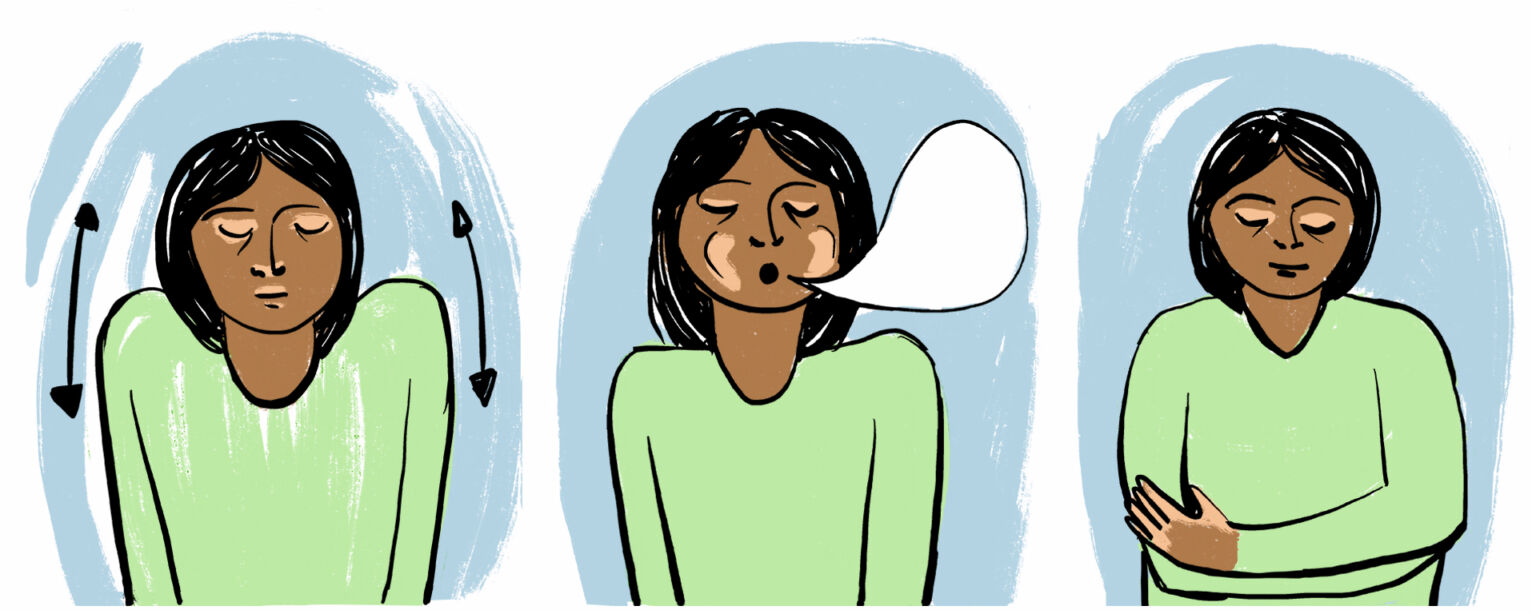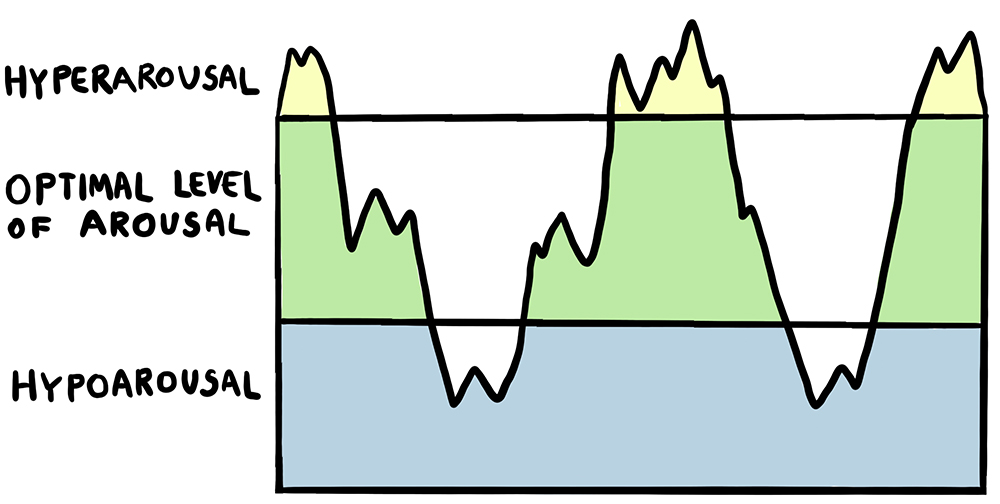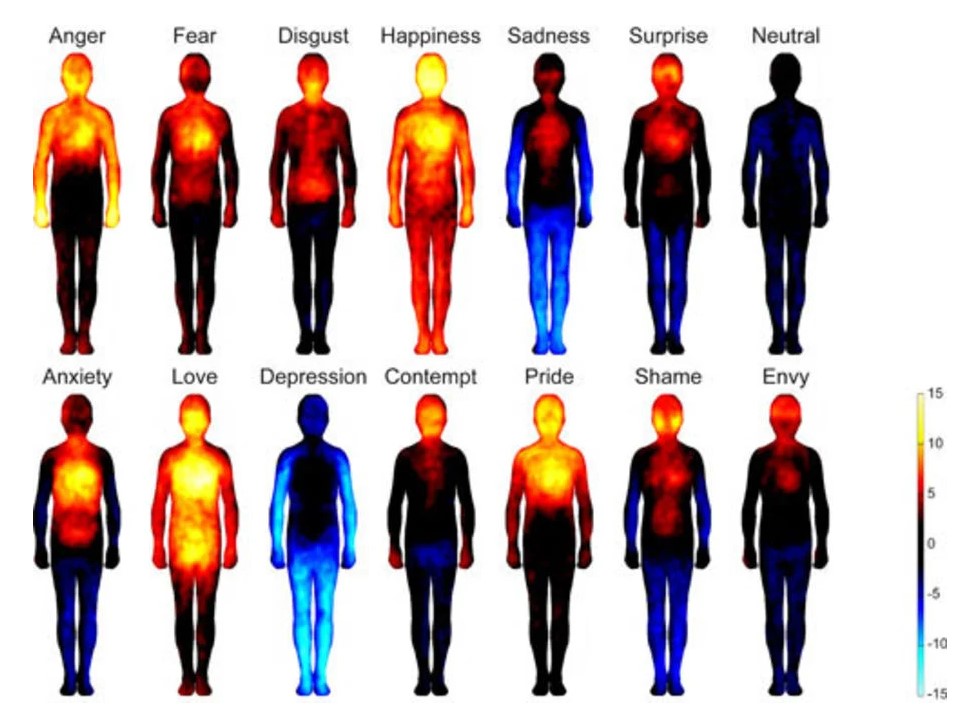
The mind-body connection
Physical changes brought about by emotions are the basis of how we experience emotions. Our emotions guide our behaviour and the function of our central and peripheral nervous systems. Emotional experiences in the brain take place in the body. Feelings can show outwardly as facial expressions, body language, and tone of voice. The way that we experience an emotion can also be changed by changing our body language. For example, if you feel tense, relaxing the neck and shoulders can reduce the feeling of tension.
Regulating arousal
Emotional arousal refers to the prevailing energy level in the mind and body at a given moment. Look at the window of tolerance in the picture below to help you gauge how your level of arousal changes over the course of the day. We are best able to regulate our feelings when we are at an optimal level of arousal. It is particularly important to practice regulating our arousal levels in parenthood so that we can interact well with our children. Regulating arousal levels also affects coping and wellbeing in everyday life.

Over the course of the day, our arousal levels vary within the window of tolerance between hyperarousal and hypoarousal. It’s natural to be closer to hyperarousal during the busiest part of the day and closer to hypoarousal just before going to bed at night time.
In a state of hypoarousal, you may feel melancholy and sluggish, and even depressed or lethargic. In such a state, it can often be a struggle to express emotions, your mind and body slow down, and it may be difficult to feel positive emotions. On the other hand, in hyperarousal, our range of thoughts narrow, our mind and body become restless, and we may experience anxiety, aggression, or difficulty concentrating. Changes in arousal can be felt in the mind and in the body.
You can practice regulating your arousal levels by keeping to everyday routines. Regular mealtimes, sufficient sleep, suitable exercise for your state of arousal (if you are in hypoarousal, activate yourself with a run or brisk walk, and if you are hyperaroused, stretch or go for a gentle walk), and a suitable amount of screentime can help both parents and children to stay within the window of tolerance.
If you feel that you are hyperaroused, you can practice relaxation methods, such as conscious breathing. Try to take 5 calm breaths through your nose. Feel your feet against the ground, feel how the carpet feels under your feet.
If you feel that you are hypoaroused, you can try to activate body movement by e.g. tapping on your body or going for a walk, even if it feels difficult.
Emotions in the body

Emotions can be felt in the body as various physical reactions. As a parent, you can practice noticing feelings that arise in various everyday situations in your own body. For example, if you begin to become irritated, you may clench your fists, tense your muscles, or go red in the face. Joy can feel like bubbly energy in your stomach. If you feel gratitude, your upper body relaxes, and warmth fills your chest.
Emotions are felt in the body in waves, and it’s important to be able to face the waves while calming yourself down. Waves come and go. Sometimes things are stormy, and other times they are calm. You can read more about emotional regulation and arousal levels in the next task.
- In the picture above, the cold blue colours depict a decrease in activity and the red colours depict a rise in activity. Look at the picture and think where in your body you feel those feelings. You can also come up with other emotions besides the ones in the picture.
- How would you describe the feeling of pressure in your body for different emotions? Where do you feel the pressure? Is it stronger for certain emotions?
- Which colours would you use to depict the different emotions in your body?
- Can you feel emotions in your body when they begin to arise?
- If you wish, you can draw similar people and colour them with your own emotional experiences.
Once you have identified an emotion in your body, you can name it and say it to yourself. When you name an emotion that you feel, try to give yourself permission to feel it as it is. You can practice explaining them to your partner, child, or friends. For example, “I notice that I’m tired and irritable right now,” or “I’m happy that you came to visit”.
Anger management exercise
- Pay attention to how your body changes when you start to feel anger or irritation.
- Try to consciously relax your neck and shoulders. Lift your shoulders three times, tense them there, and then relax them and let them drop back.
- Take 10 really deep breaths. Breathe in until your lungs are full, hold your breath for a moment, and then exhale calmly.
- Touch your arms and let the anger slowly fade away.
